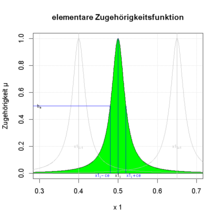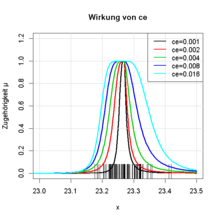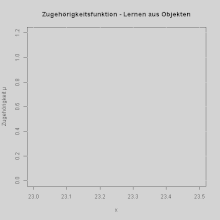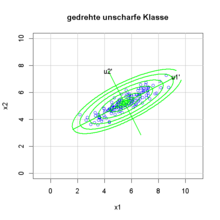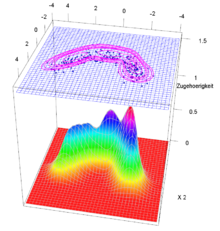Fuzzy classification
Fuzzy pattern classification is a method for describing class systems ( classification ) from structured observations (objects), which are present as feature vectors in the one- or multi-dimensional Euclidean feature space , for the purpose of classifying unknown observations (objects) in the class systems described in this way ( Classification ).
The method of fuzzy pattern classification was developed in the 1970s and 1980s by the TH Karl-Marx-Stadt (today TU Chemnitz ) and described in detail by Bocklisch. The process has been used in a wide range of applications in various specialist disciplines. It has u. a. Proven in medical diagnostics, in the monitoring and diagnosis of machines and systems, in the analysis and prognosis of time series problems such as traffic flows, environmental data and in the quality monitoring of manufacturing processes .
Basics of the method
The fuzzy pattern classification is based on the uncertainty of the classes formed from individual observations and uses the concept of the membership function. The membership function μ KL : X → [0,1] assigns a number from the real-valued interval [0,1] to each object x of the feature set X , which indicates the degree of membership μ KL (x) of the object to the so defined fuzzy set (class) KL indicates. In addition, the uncertainty of each individual observation or each object due to methodological problems, measurement errors, etc. assumed. This uncertainty is expressed by assigning an elementary uncertainty to each object.
The method uses for the class description of a specific method of supervised learning ( supervised learning ) of structured, blurred example objects, d. H. from objects that have been assigned to a class by a "teacher" or "expert". Both the elementary fuzziness of the objects and the fuzziness of the classes are expressed by a uniform parametric model of a unimodal , asymmetric potential function according to Aizerman .
Fuzzy class description
Elementary blurring of objects
It is assumed that each individual object is fuzzy, about which explicit information is generally not available and an asymmetrical membership function is not justified. Therefore, for the sake of simplicity, the parameters of the elementary membership function for the right and left side are equated and, according to Bocklisch, the following parameter values are assumed: b = 0.5 d = 2 c e is called elementary uncertainty. It can be specified by expert estimates or obtained from an error estimate of measured values. The elementary membership function has the form:
- .
The elementary fuzziness is defined globally for each feature axis and is thus defined for all objects. As a controlling parameter, it is responsible for the form and expansion of the class and has a great influence on almost all parameters of the fuzzy description of a class. Their effect is comparable to that of the bandwidth h in the kernel density estimation . When describing rotationally adapted classes, care should be taken to adapt the elementary fuzziness by characteristics.
One-dimensional class description
The fuzzy pattern classification uses a heuristic approach to describe class membership functions for the class KL from objects x1 i with elementary fuzziness and a feature x1 in the one-dimensional feature space .
The parameter x1 0 can be calculated from the centers of gravity of the objects x1 i :
- .
The parameter b KL determines the membership value at the sharp boundary of the class x 0 KL -c KL . In order to achieve greater flexibility in adapting the class membership function to the distribution of the learning objects, the Aizerman potential function can be divided into two sections, for which the parameters b l KL and b r KL are calculated separately. For the calculation, the areas of the elementary membership functions are disjunctively linked ( aggregated ) on the left and right and then normalized.
The parameters c l KL and c r KL can be understood as the position of the edge objects of all learning objects for class KL :
- .
The parameter d should reflect the distribution of the objects belonging to the class. It determines the form of the membership function. It applies to :
- ; preferably whole numbers.
For a sharp class (set) theoretically d = ∞ holds. In practice, a sharp delimitation of the class is achieved with about d = 20.
The parameter d can be specified by an expert (teacher). Bocklisch describes an algorithm to calculate d from the increments of the objects:
- .
- .
- .
Multi-dimensional class description
Multi-dimensional membership functions in the feature space according to the parametric concept of fuzzy pattern classification are described by n one-dimensional membership functions each with n parameters and a subsequent logical link. The Hamacher t-Norm is used as a logical link .
It is assumed that n one-dimensional membership functions of the form <>:
- , where the parameter term of the Aizerman potential function is:
- . After applying the logical connection with the Hamacher t norm:
- After simplifying the expressions, one obtains for n membership functions the following representation:
- .
The combination described has the disadvantage that the memberships <1 converge to 0 as the dimension increases. This can be avoided by taking the arithmetic mean. This results in the n-dimensional membership function:
- .
A detailed discussion of the parameter calculation for the class membership function can be found in Päßler.
classroom
The feature space is spanned by the features ( ). It is advantageous to carry out a coordinate transformation of all objects belonging to a class before the fuzzy description of the classes in order to obtain a better adaptation of the fuzzy class to the present data structure. Class-specific sub-rooms are created, which are referred to as classrooms. Each classroom is spanned by an n-dimensional, class-specific axis system ( ), which is shifted in relation to the origin of the feature space and, in most cases, rotated in the feature space ( ). The origin of the classroom KL lies in its representative - the focus of the objects that make up the class. For rotational adjustment, the orthogonal class system is rotated in the direction of the main axis of gravity. Rotation angles φ i + 1 serve as additional parameters for the class description in n dimensions .
Classifier and fuzzy identification
A fuzzy class model usually consists of k different classes. Every single class j has its own meaning. The totality of all classes is called a classifier. With a given concept, the classifier is a parameter set for each individual class j with the parameters of all n one-dimensional membership functions . With its help, an object (a feature vector ) can be assigned a membership value for each class. This creates a vector of affiliation or sympathy . For each component of the sympathy vector:
- .
The calculation of the sympathy vector for a given feature vector of an object is called identification by Bocklisch. The image on the right shows the identification of an object (magenta). The object is assigned a membership value for each of the three classes .
The use of the method of fuzzy pattern classification is classification , i. H. the classification of unknown observations (objects) in one of the classes of the class system. This requires a sharp decision by evaluating the membership vector. Often the maximum is chosen for this purpose, the maximum membership value being able to be assessed as a measure or also as the quality of the assignment to the class.
One example of this application is process monitoring in resistance spot welding .
Extension of the method
The fuzzy pattern classification is a data-based learning process that enables optimal adaptation of the classes to the underlying data, provided that these are largely unimodal and have a convex distribution. Multimodally distributed and non-convex object sets can be split up into compact unimodally distributed sets by segmentation with the help of clustering methods, each of which can be described blurredly according to the concept.
A way of describing non-convex object sets with the fuzzy pattern classification in a fuzzy way is suggested by Hempel. The idea is to supplement the object-supported areas of the feature space with non-object-supported complementary areas.
Another possibility of generating membership functions from non-convex object sets is offered by multivariate kernel density estimation , in which the rather cumbersome way of describing the fuzzy class by determining anticlass is no longer necessary.
credentials
- ↑ a b c d e f S. F. Bocklisch: Process analysis with fuzzy procedures. Verlag Technik, Berlin 1987, ISBN 3-341-00211-1 .
- ↑ R. Fletling: Methodical approaches for fuzzy pattern recognition in deformation measurement results . Dissertation . TU Braunschweig, 2010, DNB 1015893058 .
- ↑ G. Herbst: Fuzzy methods for local phenomena in time series. Dissertation. TU Chemnitz, 2011, DNB 1017145644 .
- ↑ SF Bocklisch, J. Burmeister: PROCEDURE FOR GUETESICHERUNG DES FUEGENS. Patent DD265098A1
- ↑ M. Päßler: Multi-dimensional time series modeling and prognosis using fuzzy pattern models. Thesis. Chemnitz University of Technology, 1998.
- ↑ a b A-J. Hempel: Net-oriented fuzzy pattern classification of non-convex object set morphologies. Dissertation. TU Chemnitz, 2011, DNB 1018438610 .
- ↑ a b Tarn Duong: Package ks of the programming language R ', Version 1.9.2 (2014)
- ↑ Hao Wang: Multivariate density estimation in exploratory data analysis. Dissertation. University of Augsburg, 2009, DNB 1005117373 .

